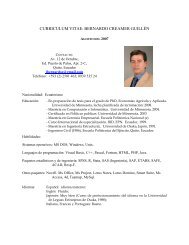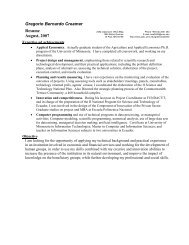Water-Quality Trading: Can We Get the Price of Pollution Right?
Water-Quality Trading: Can We Get the Price of Pollution Right?
Water-Quality Trading: Can We Get the Price of Pollution Right?
Create successful ePaper yourself
Turn your PDF publications into a flip-book with our unique Google optimized e-Paper software.
5.3.2 Case B: α 1 = 15.0, α 2 = 7.5, α 3 = 15.0In this case, a high-cost firm is located downstream <strong>of</strong> two low-cost firms. At <strong>the</strong> social optimum,source 3 abates all <strong>of</strong> its emissions while source 2 emits <strong>the</strong> most (Table 2). Efficient trades shouldoccur under <strong>the</strong> TRS, because this system allows <strong>the</strong> high-cost downstream source to buy permitsfrom <strong>the</strong> two low-cost upstream sources. Indeed, this is exactly what happened in <strong>the</strong> simulation.Each firm is allocated 18.5 units <strong>of</strong> discharge permits-+ initially in both <strong>the</strong> TRS and <strong>the</strong> DTRS.In <strong>the</strong> TRS equilibrium, firm 2 bought 14.4 units from source 3 to increase its emissions to 32.9while firm 3 sold 18.5 units at <strong>the</strong> trading ratio τ 32 ≈ 0.78 (i.e. 18.5×τ 32 = 14.4 units for source 2).Note that under <strong>the</strong> TRS, <strong>the</strong> downstream firm has a choice <strong>of</strong> buying permits from ei<strong>the</strong>r source1 or source 3. Therefore, if <strong>the</strong> effective price <strong>of</strong> permits from source 1 is higher than that fromsource 3, <strong>the</strong>n source 2 would buy permits from source 3 and vice versa.It follows <strong>the</strong>n that <strong>the</strong> effective equilibrium prices are equalized across space: p 1 = τ 12 p 2 =τ 32 p 2 = p 3 . At this equilibrium price, source 1 has no incentive to sell its permits to source 2and thus ends up emitting exactly at <strong>the</strong> initial allocation. The trading outcome in <strong>the</strong> DTRS issimilar. Source 3 abates its emissions down to zero and sells its permits mostly to source 2. Adifference occurs, because source 3 also sold its permits to source 1. As we have noted, under <strong>the</strong>DTRS firms located in different branches are allowed to trade, and <strong>the</strong> equilibrium prices satisfyp 1 = (d 1 /d 2 )p 2 = (d 1 /d 3 )p 3 . It turns out that at <strong>the</strong>se equilibrium prices, it is cheaper for source 1to buy permits from source 2. As a result, source 1’s equilibrium emissions are slightly higher under<strong>the</strong> DTRS than under <strong>the</strong> TRS while source 3’s equilibrium emissions are lower under <strong>the</strong> DTRSthan under <strong>the</strong> TRS. The extra trade between source 1 and source 3, however, decreased efficiencyslightly, compared to <strong>the</strong> TRS equilibrium. This is because <strong>the</strong> damage-denominated tradingcoefficients, <strong>the</strong> d i ’s, are poor approximations <strong>of</strong> <strong>the</strong> true marginal damages at <strong>the</strong> optimum, asshown in Figure 2. In this case, <strong>the</strong>refore, <strong>the</strong> DTRS encouraged inefficient trades. Note, however,that both TRS and DTRS closely approximate <strong>the</strong> social optimum in this case.5.4 <strong>Price</strong>s vs. quantitiesOn one hand, our numerical analysis suggests <strong>the</strong> impossibility <strong>of</strong> getting prices right in watershedshaving certain characteristics. Nei<strong>the</strong>r <strong>the</strong> TRS nor <strong>the</strong> DTRS succeeds in providing <strong>the</strong> correctprice signals for water-quality trading. On <strong>the</strong> o<strong>the</strong>r hand, our analysis also indicates that in somecases, <strong>the</strong> equilibria approximate <strong>the</strong> social optimum quite closely. <strong>We</strong> obtained <strong>the</strong>se results bysetting <strong>the</strong> total supply <strong>of</strong> permits equal to <strong>the</strong> socially optimal level. A natural question <strong>the</strong>nis, which type <strong>of</strong> inefficiency is larger: not getting <strong>the</strong> prices <strong>of</strong> pollution right or not getting <strong>the</strong>quantity <strong>of</strong> permits right? <strong>We</strong> investigate this question by simulating <strong>the</strong> trading outcomes forvarying levels <strong>of</strong> <strong>the</strong> supply <strong>of</strong> permits (in percentage reduction from <strong>the</strong> baseline discharge level)and allocating permits in equal number to each discharger. The result is shown in Figure 3.First, <strong>the</strong> relative performance <strong>of</strong> <strong>the</strong> two systems varies, in an unsystematic way, with <strong>the</strong>supply <strong>of</strong> permits. In Case A (α 1 = 7.5, α 2 = 15, and α 3 = 7.5) where a low-cost source is locateddownstream <strong>of</strong> two high-cost sources, <strong>the</strong> DTRS performed substantially better than TRS when <strong>the</strong>total supply <strong>of</strong> permits was kept to <strong>the</strong> socially optimal level. This is because <strong>the</strong> TRS prohibitedany trade from taking place. However, when <strong>the</strong> total supply <strong>of</strong> permits is reduced to 60-70% <strong>of</strong> <strong>the</strong>baseline discharge level, <strong>the</strong> TRS performs better than <strong>the</strong> DTRS despite <strong>the</strong> fact that no tradingstill takes place under <strong>the</strong> TRS. This occurs because <strong>the</strong> efficiency loss due to <strong>the</strong> TRS precludingtrading was outweighed by <strong>the</strong> efficiency loss due to <strong>the</strong> DTRS encouraging inefficient trades,which increased environmental damages substantially relative to no trade. In contrast, in Case B(α 1 = 15.0, α 2 = 7.5, and α 3 = 15.0), in which a high-cost source is located downstream <strong>of</strong> two19



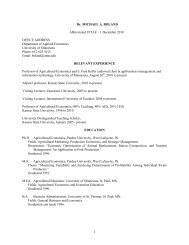
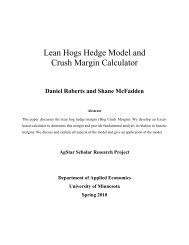
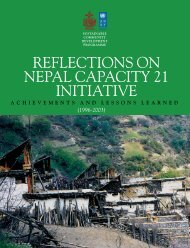
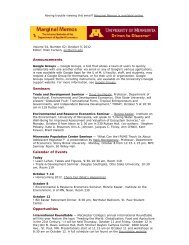

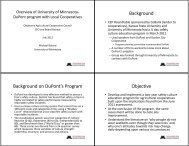
![Publications Since 2000[1].docx](https://img.yumpu.com/30237513/1/190x245/publications-since-20001docx.jpg?quality=85)

